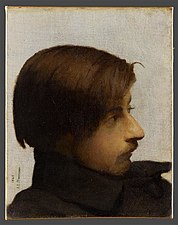Jean-Louis Hamon

Jean-Louis Hamon (5 May 1821 – 29 May 1874) was a French painter.[1]
Hamon was born at
Lamennais, but his strong desire to become a painter finally triumphed over family opposition, and in 1840 he left Plouha for Paris—his sole resources being a pension of five hundred francs, granted him for one year only by the municipality of his native town.[1]
At Paris Hamon received valuable advice and encouragement from
Salon with Le Tombeau du Christ (Musée de Marseille), and a decorative work, Dessus de Porte. The works which he exhibited in 1849, Une Affiche romaine, L'Égalité au sérail, and Perroquet jasant avec deux jeunes filles, obtained no marked success.[1]
His lack of success led Hamon to accept a job as a designree in the
legion of honor.[1]
In the following year he was absent in the East, and in 1857 he reappeared with Boutique à quatre sous, Papillon enchaîné, Cantharide esclave, Dévideuses, etc., in all ten pictures; L'Amour en visite was contributed to the Salon of 1859, and Vierge de Lesbos, Tutelle, La Volière, L'Escamoteur and La Sœur aînée were all seen in 1861.[1]
Hamon now spent some time in
Mediterranean, close by Alphonse Karr's famous garden. In this house he died on 29 May 1874.[1]
A school in his home town of Plouha was named after him, and a monument was erected to him by the
Blues of Brittany
.
Gallery
- Jean-Louis Hamon
-
Jean-Louis Hamon (self portrait)
-
Portrait of Auguste Toulmouche
-
La Comédie humaine (1852)
-
Old China Shop (Pompeii)
-
Entomologist (Design for a Fan)
References
- ^ a b c d e f One or more of the preceding sentences incorporates text from a publication now in the public domain: Chisholm, Hugh, ed. (1911). "Hamon, Jean Louis". Encyclopædia Britannica. Vol. 12 (11th ed.). Cambridge University Press. p. 900.
External links
Wikimedia Commons has media related to Jean-Louis Hamon.





